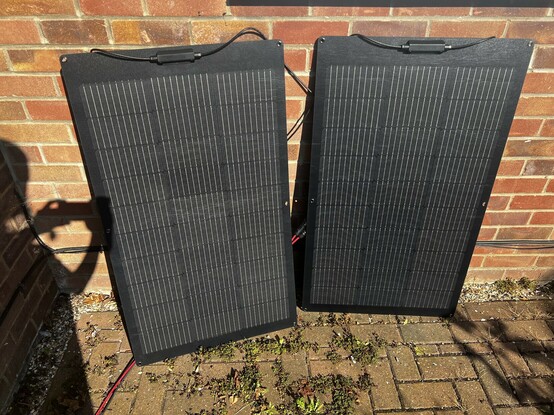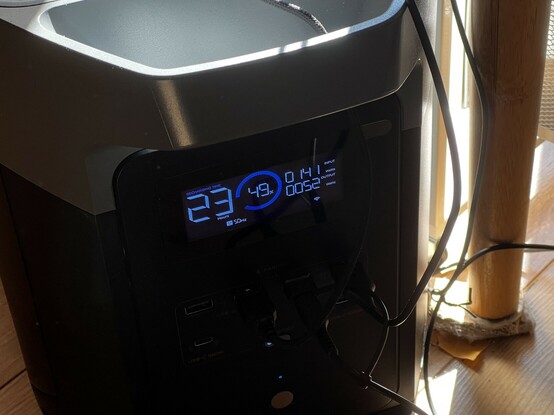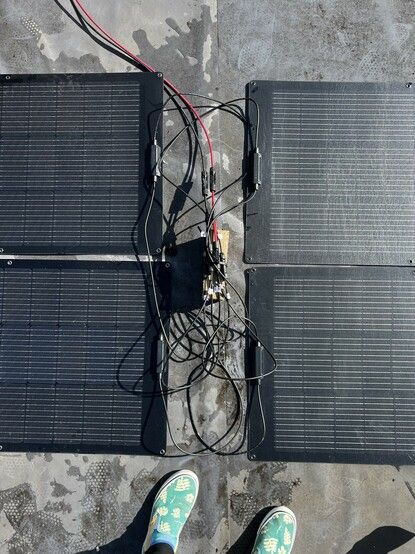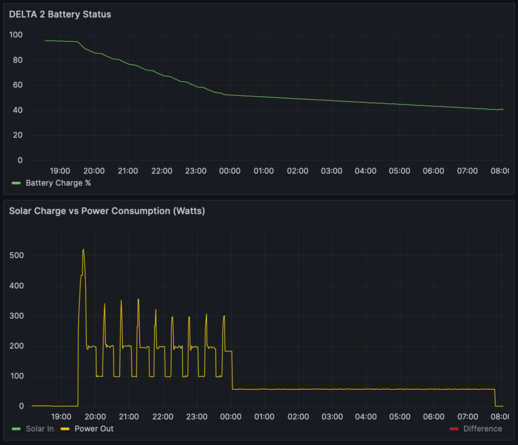Off-grid Office Continued
EcoFlow sent me the DELTA 2 Max back in early June and it sat doing more or less nothing until I received and installed a modest 400W of their flexible solar panels in late July. Since then – and with the help of some detailed data mining via InfluxDB and Grafana – I’ve very quickly been able to get a feel for how my off-grid office might take shape. I’ve also realised the large part the DELTA 2 Max plays as both storage to smooth over the very intermittent solar, and as a means to make me acutely aware of my workstation energy usage.
My off-grid office plans have been dialled back for the moment, though I think they are still feasible. I have resolved to use the DELTA 2 Max to power only my main workstation, which consists of an Alienware m15 r3 laptop, a Thunderbolt or USB Type-C dock depending on what I have on test, two 27” LG monitors and various peripherals. This setup uses roughly 45W to “idle”, when my monitors are off and my laptop is locked but still running, and anywhere from 90W to 160W while in use. This amounts to around 900Wh of daily, active power use and somewhere around 800Wh of overnight idling, though the active use figures can vary widely depending on what I’m doing and for how long.
The solar saga continues. I leaned a couple of panels up against the wall facing roughly into the sun. This is 200W capacity putting out ~140W. Not bad for a no-effort setup. Also proves the cables I ordered work.
This setup has very quickly made me realise two things- if I want to be properly “off-grid” I need a lot more solar capacity (I was originally expecting at least 800W), and I need more battery capacity.
More Solar Panels
First off, let’s talk solar. The four, 100W, flexible solar panels I’m currently using are nominally a combined 400W but will output anywhere from nothing (at night, or in adverse weather) right up to about 440W in very oddly specific conditions with one anomalous peak even reaching 479W.
Flexible solar panels tossed up onto a flat roof actually work reasonably well. Since they’re light weight and take a little bit of bending in their stride I could stack the lot up and heft them into the roof by myself. Now I’ve tidied up the cables and kept them out of standing water by zip-tying them to a brick.
On any given day there tends to be a peak around the middle of the day, which you’d expect since… y’know… the sun is right up in the sky. Applying a 30 sample moving average shows that this peak typically doesn’t exceed 200W in any given half hour. Taking the sum of all energy generated each day shows that the total solar generation for a good day is 1kWh, with that happening from 7am to 7pm or roughly 80W an hour. It has been a consistently overcast, miserably, rainy week so this is entirely unsurprising. I’m taking some liberties with the maths here, but the daily generation and usage figures correlate strongly with the battery charging and discharging. This is good, since I only have power data with a one minute granularity and it seems the battery is charging more than my data would suggest, making my figures comfortably pessimistic.
But what does this all mean? Let’s summarise the facts-
I use roughly 900Wh of power during the day. Plus 800Wh of power during the night. The 400W solar panels generate, at best, about 1000Wh.
That’s a shortfall of 700Wh.
Now let’s assume I could generate 2KWh from solar in a day using a combined 800W solar setup. The DELTA 2 Max has roughly that capacity, so on a good day it would be charged from 0 to 100%. But, what if it’s already at 50% capacity? I’m off-grid, remember, so there’s no export of excess power happening here. I need to put it somewhere-
More Batteries
The biggest challenge in this off-grid setup seems to be managing the delicate balance between generating too much power, and not enough power. If the battery is full, and the following morning happens to be sunny then I’m throwing away that potential for energy generation. Similarly if the battery is empty and there’s no sun, I have to throw my wall switch and resort to using power from the grid.
This problem is exacerbated by my little friends Saturday and Sunday. In fact on the last Saturday of July my computer was unused and the sun was shining. The DELTA 2 Max battery charged from roughly 50% to 95%, or just under 1kWh. With the battery at full capacity, and another day of weekend to come, I had to come up with creative ways to bleed off that power so I could harvest the Sunday morning sun. I did this by lugging the DELTA 2 Max indoors, hooking it up to the WAVE 2 and cooling our bedroom for roughly six hours, followed by another seven hours of idling. This took the DELTA 2 Max’s battery back down from 95% to 40% capacity. It’s pretty neat to be able to do this, but it’s also very, very impractical.
I decided to haul the EcoFlow DELTA 2 Max indoors to use some of the solar energy I'd gathered during the day to power the WAVE 2 air conditioner. I was still logging power usage and battery data so I accidentally got the best graph of power usage yet. It shows roughly what a full drain on the 1kWh WAVE 2 battery would look like.
Another reliable method to store power is – of course – more batteries. I found that charging my various portable batteries from the DELTA 2 Max, using any surplus capacity, was a great way to load-shift that excess sunshine. In fact the DELTA 2 Max might have been the first device I was able to charge my Anker 737 battery at a full 100W from. Unfortunately even the biggest of my batteries is a drop in the ocean for the DELTA 2 Max’s 2048Wh capacity- at one point I had two 12v tool battery chargers, a laptop and my Anker battery connected in a desperate bid to use that surplus weekend power.
The DELTA 2 Max capacity can be increased via way of a battery extension cable out to an expansion battery. These “Smart Extra Batteries” as EcoFlow calls them add an additional 2kWh, and you can connect two to the DELTA 2 Max for a combined storage of 6kWh. If you’re keeping up with the numbers, that’s roughly enough to run my workstation for a week.
As luck would have it, I have the 1kWh expansion battery for the WAVE 2 which would make for a great way to tote excess power from the DELTA 2 Max up to the WAVE 2 for heating/cooling or, by means of its integrated USB Type-C port, to charge laptops and devices around the house.
Data, data, data
I have been using a modified version of EcoFlow Exporter to grab all of the data that the DELTA 2 Max spurts into the MQTT server that forms the backbone of EcoFlow’s app-to-device communication setup. This has given me a fantastic level of insight into the performance of the panels and the charge level of the battery.
I’ve been using a Python script to heft all of the data from EcoFlow’s DELTA 2 Max into an InfluxDB server running on my old Intel NUC. I then use Grafana to produce pretty graphs.
It’s also made me acutely aware of just how much power I’m using, and forced me to make decisions about how best to conserve (or sometimes even use) it.
Stay tuned for my review of the DELTA 2 Max.





